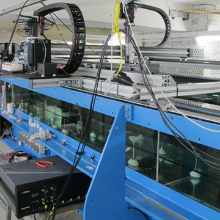The laminar water channel at the Institute of Aerodynamics and Gas Dynamics is a facility for experimental investigations on flow phenomena in the laminar boundary layer. Since its completion in the year of 1987, this channel enabled various research projects which gave rise to a number of significant publications and theses.
Some of the most significant research projects were investigations on the evolution of small disturbances, laminar separation bubbles and the effects of wall roughness in the laminar boundary layer.
Despite the growing importance of Computational Fluid Dynamics (CFD), observations from a physical experiment remain essential. In contrast to wind tunnels, the usage of water as an operating fluid allows for larger lengths- and time scales, which results in greater spatial and temporal resolution. This improves the quality of quantitative measurement techniques such as Particle Image Velocimetry and Hot-wire Anemometry, which is both in use at the channel. Furthermore, water provides unique possibilities for flow visualizations such as hydrogen bubbles, Tellur or color.
In the last research project, the effects of isolated roughness elements on the stability of laminar boundary layers has been investigated. As a result, the critical Reynolds number from 3-D global linear stability theory was confirmed in the laminar water channel, supporting latest theoretical advancement. This project has been financed by the German Research Foundation (DFG).
- Type
Closed-loop
Sandwich construction - Velocities
0.05 – 0.2 m/s - Turbulence Intensity
0.05 % (0.1 - 10 Hz at 0.145 m/s) - Fluid
Water (30m 3) - Contraction ratio
7.7:1 (with open water surface) - Settling chamber
- 2 honeycombs at the exit of the diffusor
- 10-times crosswise textile screen
- 2 additional textile screens
- Precision screen made from stainless-steel wires (diameter 0,1 mm) - Mechanical isolation
- Air-bellow suspention towards the floor
- Rubber ring between pumps and channel
- Belt drive to connect to the motor - Thermal regulation
- Room in the basement with heat insulation
- Temperature-regulated air supply
- Temperature deviation less than 0.05°C each day - Test section
- 10 m (L) x 1,2 m (W) x 0,15 m (H)
- open water surface
- flate plate in the test section, forming a "fresh" boundary layer
Research
The puzzle of why flows change their state from laminar to turbulent beyong a certain critical Reynolds number has been struggling engineers for more than a century. Linear stability theory (LST) plays an essential role in this discipline and predicts instabilities based on eigenvalues. The three-dimensional (3-D), global LST is a new theoretical tool, which can be used in particular for complex 3-D flows such as for instance behind a surface roughness element.
To confirm the predictions of 3-D, global LST, our unique flow facility has been equipped with modern measurement equipment and flow visualization methods. To detect the physical effects of a roughness in the Blasius boundary layer and compare to theory, variable roughness elements made from stainless steel are used. Interestingly, great agreement was found in this comparison, however, there are also deviations with important practical implications.
For industrial applications, for instance, tolerable roughness dimensions are required to ensure the quality of a surface from an aerodynamical point of view. Prior to our experiments, it was unclear to which extent such tolerances can be determined from 3-D global LST. The contribution to the current state-of-the-art can be found in "Publications" on this site. We expect further valuable results on this or other topics on boundary-layer theory in future.
- PUCKERT, D. K. & RIST, U. 2018 Experiments on critical Reynolds number and global instability in roughness-induced laminar-turbulent transition. J. Fluid Mech. vol. 844, pp. 878-904.
- PUCKERT, D. K. & RIST, U. 2018 Global instability in a laminar boundary layer perturbed by an isolated roughness element. Exp. Fluids 59:48.
- BUCCI, M. A., PUCKERT, D. K., ANDRIANO, C., LOISEAU, J.-C., CHERUBINI, S., ROBINET, J.-C. & RIST, U. 2018 Roughness-induced transition by quasi-resonance of a varicose global mode. J. Fluid. Mech. vol. 836, pp. 167-191.
- PUCKERT, D. K., DIETERLE, M. & RIST, U. 2017 Reduction of freestream turbulence at low velocities. Exp. Fluids 58:45.
- PUCKERT, D. K. & RIST, U. 2016 Transition downstream of an isolated cylindrical roughness element on a flat plate boundary layer. In New Results in Numerical and Experimental Fluid Mechanics XI (ed. Dillmann, G. Heller, E. Krämer, R. Radespiel & C. Wagner), Springer.
- OST, J., MÄTELING, E., KLEIN, C., PUCKERT, D. & RIST, U. 2016 Reattaching Flow Behind a Square Bump Investigated with Temperature Sensitive Paint In New Results in Numerical and Experimental Fluid Mechanics XI (ed. Dillmann, G. Heller, E. Krämer, R. Radespiel & C. Wagner), Springer.
- PUCKERT, D., SUBASI, A., RIST, U. & GUNES, H. 2015 Experimental investigations of critical roughness heights in a laminar boundary layer. In The 13th International Symposium on Fluid Control, Measurement and Visualization, FLUCOME2015, Doha, Qatar.
- SUBASI, A., PUCKERT, D., GUNES, H. & RIST, U. 2015 Calibration of constant temperature anemometry with hot-film probes for low speed laminar water channel flows. In The 13th International Symposium on Fluid Control, Measurement and Visualization, FLUCOME2015, Doha, Qatar.
- SHIN, Y.-s., RIST, U. & KRÄMER, E. 2015 Stability of the laminar boundary-layer flow behind a roughness element. Fluids 56, 11.
Contact

Ulrich Rist
apl. Prof. Dr.-Ing.Former head of the working group Boundary Layers





